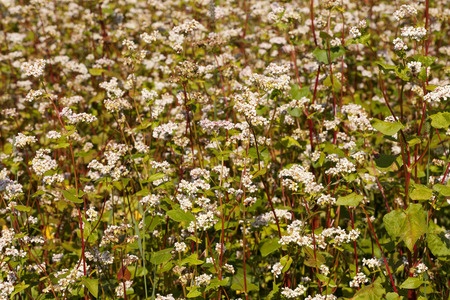Buckwheat - Fagopyrum sagittatum

Common Names: Buckwheat, Common Buckwheat, Japanese Buckwheat, Silverhull Buckwheat, Beechwheat, Soba, Saracen Corn, Sarrasin, Heidekorn, Buchweizen, Grechka, Tatarka, Fagopyrum sagittatum, Fagopyrum esculentum, Boekweit, Blé noir, Wheat, Beech-wheat
Latin Name: Fagopyrum sagittatum
Origin: Asia, Australia, Europe, South America, North America
Short Introduction
Buckwheat is a highly adaptable crop, thriving in light, sandy-loam soils and requiring only minimal nutrients and care. Sown typically in May, once frosts have passed, it matures quickly and is often harvested between August and September. Its short growing season allows for cultivation as an intercrop, making it favored by farmers in regions with condensed climates or shorter summers.
Historically, Russia was the largest producer of buckwheat, with France following behind. Today, China and Russia remain the global leaders. Once common in North America, buckwheat’s cultivation decreased as fertilizer use in cereals increased, but it remains prized for adaptation and soil improvement. Buckwheat tolerates poorer, acidic soils, but relies on adequate moisture during flowering and seed formation to ensure high yields.
Detailed Description
An excellent gluten-free grain prized for its cleansing properties.
Botanical Information
Buckwheat (Fagopyrum sagittatum) is an annual herbaceous plant that typically grows 50–80 cm tall (but can reach up to 140 cm). Its stems are reddish-brown, hollow, upright, and delicately branched. The lower leaves are petiolate, while upper leaves are sessile, all heart-shaped and arrowhead-like, with a generally triangular blade.
Buckwheat’s inflorescences arise from the leaf axils and are arranged in racemes. The bisexual flowers range in color from white to pink or even red. The fruit is a three-sided achene, with a dark brown to gray hue. Once the hull is removed, the seeds (groats) resemble traditional cereals in shape and composition. The outer hull is a single, thick, pale green cell layer that is easily separated due to its lower density than water. The plant produces a deep, primary taproot with many finer branches and adapts well to new environments by sending out creeping shoots from its base.
Origin and Distribution
Though widely cultivated today, buckwheat is not native to Europe; its origins are believed to be in Southeast Asia or possibly southern Siberia and northern China. It was domesticated around 6000 BCE in the Yunnan province of China, then spread via trade and agriculture into Central Asia, Tibet, the Middle East, and eventually Europe, likely through migrating tribes and commerce. The first European records are from present-day Finland and the Balkan region during the Neolithic. In several languages, buckwheat’s name reflects its foreign origin, such as the Russian 'grechka' (Greek) or the French 'Saracen corn.'
Buckwheat naturalizes readily and is found throughout Asia, Europe, and North America. Crusaders are said to have introduced it to Western Europe. In medieval Europe, especially France, it was called 'Saracen grain' due to its introduction from the East.
Usage / Dosage
Buckwheat flour is occasionally used to make bread but is more popular in pancakes, which take on a delicious, subtly sweet flavor and a deep pinkish hue. These buckwheat pancakes are a traditional North American winter breakfast, usually topped with maple syrup. Dutch children enjoy buckwheat pancakes for their high nutritional value and easy digestibility.
In the Himalayan region of India, buckwheat is grown widely and consumed during fasting periods. In China and Mongolia, it is an essential cereal crop, while in Japan it is famously milled into flour for soba noodles and dumplings. Buckwheat seeds are also eaten steamed or ground into special breads like Manju. The young leaves can be consumed raw as a vegetable, and other plant parts are used for livestock fodder. In Russia, buckwheat groats (kasha) are a staple food, often served with butter, tallow, or hemp oil. Buckwheat is also distilled into beverages ranging from English whiskies to Japanese shochu.
Buckwheat is valued for providing easily digestible protein, a balanced fat profile, and high rutin content—a flavonoid that supports vascular health and helps reduce LDL cholesterol. The hulls make a nutritious tea, rich in iron. Studies have shown that rutin in proper concentrations supports chronic venous insufficiency and may help manage cardiovascular function. Formerly sold as Fagorutin in Europe, a variety of rutin supplements are now widely available.
Ongoing research highlights the potential of D-chiro-inositol, a compound from buckwheat, in the support of polycystic ovary syndrome (PCOS), with promising outcomes in preliminary studies. Other research into buckwheat’s concentrated protein and fiber has shown positive effects on reducing blood cholesterol, body fat, and gallstone formation compared to traditional wheat products.
Animal studies also indicate that buckwheat’s active compounds can positively impact cardiovascular parameters, providing scientific support for its traditional uses. Buckwheat extracts have shown benefits for respiratory health, both for healthy individuals and patients with mild respiratory symptoms.
Active Compounds
Buckwheat is rich in rutin, a flavonoid known for its beneficial effect on blood vessels. It provides high levels of quality protein, all essential amino acids, dietary fiber, starch, and optimal fatty acids (notably linoleic acid). D-chiro-inositol, glycosylated peptides, and other proteins offer additional health benefits. Seeds contain significant amounts of phosphorus, calcium, iron, zinc, selenium, copper, potassium, manganese, B vitamins, choline, and vitamin E. Not containing gluten, buckwheat is an excellent grain alternative for those with celiac disease.
Traditional Dosage
Buckwheat and buckwheat-based products are found in a vast range of culinary goods and healthy foods. To make a tea, steep 1 teaspoon of dried aerial parts in 250 ml of boiling water for about 15 minutes. Drink up to three times daily. Buckwheat tea can be enhanced with lemon balm for additional flavor and benefits.
